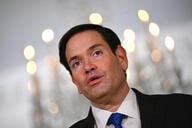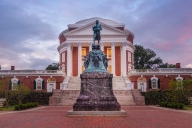You have /5 articles left.
Sign up for a free account or log in.
From Horace Mann to President Obama, and legions of politicians and educators in between, education has been heralded as the great equalizer, an institution that can balance (if not undo) racial, ethnic or other inequities that separate segments of society.
If higher education in the United States ever fulfilled that role, it is doing so less and less, not more, as time passes.
That is the stark and in many ways distressing conclusion of a report released today by researchers at Georgetown University: “Separate and Unequal: How Higher Education Reinforces the Intergenerational Reproduction of White Racial Privilege.”
The report's assertion that African-American and Latino youth -- especially those from low-income backgrounds -- are underrepresented at the nation’s 468 most selective four-year colleges and overrepresented at the 3,250 open-access two- and four-year institutions will probably surprise few; that’s a circumstance of long standing.
But it surprised even the lead researcher, Anthony Carnevale, a grizzled expert on educational access and equity, to find that the situation steadily worsened from 1994 to 2009 -- even, importantly, when comparing minority and white students with similar academic and socioeconomic backgrounds. Rather than function to reverse gaps generated by inequities in K-12 education and housing and health, Carnevale says, higher education is now serving as a "capstone" that exacerbates those other mechanisms.
"The postsecondary system mimics and magnifies the racial and ethnic inequality in educational preparation it inherits from the K-12 system and then projects this inequality into the labor market," write Carnevale and his co-author, Jeff Strohl. Carnevale is director, and Strohl director of research, of Georgetown's Center on Education and the Workforce.
"More college completion among white parents brings higher earnings that fuel the intergenerational reproduction of privilege by providing more highly educated parents the means to pass their educational advantages on to their children," they write. "Higher earnings buy more expensive housing in the suburbs with the best schools and peer support for educational attainment. The synergy between the growing economic value of education and the increased sorting by housing values makes parental education the strongest predictor of a child’s educational attainment and future earnings. As a result, the country also has the least intergenerational educational and income mobility among advanced nations."
The report is not all downbeat. Over the 15-year period it examines, African-American and Hispanic access to higher education did increase (though primarily at open-access institutions), and there are significant numbers of academically qualified minority students who could fill seats at the 468 selective colleges identified in the study (which calls them "low-hanging fruit").
But because the higher education outcomes are reinforcing patterns set much earlier in students' lives and ingrained much more deeply in the country's K-12 and housing systems, Carnevale says, altering them would take a comprehensive, many-year social policy campaign akin to the Great Society -- a prospect that seems somewhat unlikely, to say the least.
A Climb in Competitiveness
The researchers make their case with a narrative of census, educational, and work place data. The story goes something like this:
It starts with the good news: Between 1995 and 2009, the number of Hispanic and African-American freshmen enrolling in college grew by 107 and 73 percent, respectively, compared to 15 percent for white Americans. Much of this increase was driven by population gains in the minority groups, but the growth also shows that the intentional effort by advocacy groups and policy makers to increase the educational aspirations and college-going patterns of underrepresented groups worked.
But higher education has a hierarchy, and that is where the picture starts to change. The authors divide postsecondary education into three tiers: most-selective (which incorporates the most, highly, and very competitive segments identified by Barron’s), a middle “competitive” tier of four-year colleges, and all other four-year and two-year institutions, all of which essentially admit all students.
Between 1995 and 2009, the most-selective category proportionally saw the most expansion, growing in enrollment by 78 percent, from 325,068 to 578,645. (The middle tier grew to near 560,000 from 435,000, and the open-access institutions to 1.63 million from 1.35 million.) The growth in the top tier may seem counterintuitive, given that highly selective institutions typically do not grow (after all, many are selective precisely because they limit the number of students they admit, even as competition for the seats increases).
But much of the growth in students in the top competitive tiers has occurred because of significant growth in the number of colleges in those tiers. In 1995, Barron’s listed 326 in its top three levels of competitiveness (which includes at the lower end institutions with median test scores of between 1150 and 1240 on the SAT or 24-26 on the ACT, and that admit between a third and three-fourths of their applicants). By 2009, 468 colleges were in the three categories.
Just as the institutions have moved into the more selective ranks, largely in search of better rankings, the authors state, so too have students.
All racial groups had larger proportions of their college students in the top three tiers of selectivity in 2009 than they did in in 1995, as seen in the table below. But the gains for African Americans and Hispanics are tiny compared to those for whites and Asians.
Percent of Students in Top 3 Tiers of Selectivity
| Race | 1995 | 2009 |
| All | 15% | 21% |
| White | 16% | 25% |
| African-American | 8% | 9% |
| Hispanic | 11% | 12% |
| Asian | 28% | 35% |
| Native American | 9% |
13% |
Source: Georgetown Center on Education and the Workforce
More significantly, the proportion of students by race who end up in the most selective colleges – and conversely in the open-access two- and four-year colleges -- differ radically.
As seen in the graphic below, 82 percent of the additional white freshmen who enrolled between 1995 and 2009 did so at the 468 most-selective four-year colleges; just 13 percent of Latino and 9 percent of African Americans did. By comparison, 68 percent of new African-American enrollments and 72 percent of the net growth in Hispanic enrollment during those years was at the open-access institutions.

The comparative representation of the races in the more-selective and nonselective institutions is even starker when one looks at their shares of the youth population. Whites made up 62 percent of all 18- to 24-year-olds in 2009, but 75 percent of the students enrolled at the institutions in the top three tiers of selectivity, and 57 percent of those enrolled in open-access colleges. Compared to their proportions of the population over all, black and Latino students were significantly underrepresented at high-selectivity colleges and overrepresented at open institutions.
The data presented thus far open the door to the objection that is often offered when the issue of educational outcomes by race is raised: but aren’t the students less academically prepared?
To a point, yes, the authors note: “College readiness is clearly a factor in explaining African-American and Hispanic students’ access to selective education.” But the report presents data showing that even similarly qualified students of different races take different paths.
Twenty-two percent of white students who had an A average in high school end up at open-access two- and four-year colleges, compared to 30 percent of African-American and Hispanic students, the study found.
And white students with SAT scores above 1200 (or the ACT equivalent) are far likelier (77 percent) to complete a certificate or degree than are African-American (57 percent) and Latino students (56 percent) with comparable scores. Another piece of recent research supports these conclusions.

The Resources Gap
Why does it matter if groups of students are disproportionately ending up in different sorts of colleges? Because those institutions have significantly different levels of resources and their students have significantly differing kinds of outcomes, the researchers state.
The 468 higher-selectivity institutions spend about twice as much on instruction per student than do the open-access colleges (the 82 most selective colleges spend more than twice as much on average as the 468 do).
And 82 percent of students at the 468 colleges earn their degrees, compared with 49 percent of those at open-access institutions.
And that's just as true for high-achieving African-American and Latino students who make it to the magic 468, according to the Georgetown report: 73 percent students from those groups who have above average ACT or SAT scores graduate, compared to 40 percent of those who enroll at open-access colleges.
What do the data add up to?
Carnevale said they suggest to him that despite the natural inclination of Americans to believe that "gradually, things get better" -- groups that have struggled to make gains eventually will -- "at least since 1994, that's not happening" for Latinos and African Americans in terms of access to (by the report's definition) high-quality higher education. "That's not a year, that's a 15-year span," he said in an interview.
So instead of working to correct or counteract "the racial and ethnic stratification in educational opportunity entrenched in the nation’s K-12 education system" and evidenced in "white flight from the center city to better neighborhood schools in the leafy green suburbs," those inequities are increasingly being "faithfully reproduced ... across the full range of American colleges and universities."
The accumulation of data -- and the fact that in some ways the situation is worsening rather than improving -- might well leave observers feeling pessimistic about turning it around.
Carnevale cites one hopeful statistic: the fact that there are 111,000 African Americans and Hispanics who graduate in the top half academically of the nation’s high schools but do not graduate from college, and that 62,000 of them are from the bottom half of the family income distribution. They represent what Carnevale calls the "low-hanging fruit" (others call them part of the "undermatching" phenomenon) -- the students who, with increased effort from selective colleges, should be capable of succeeding there.
But many of those students don't necessarily meet the regular admissions standards of some of the more-selective colleges, and whether they will be able to give such students an edge in admissions, Carnevale said, may depend in part on the legal fate of race-based preferences in admission.
But all the affirmative action in the world won't solve the inequity that higher education is, at this point, merely replicating and reflecting, the authors argue. Because of how integrated various aspects of the problem are with one another -- "the fact that the whole system is one mechanism, one sorting device," as Carnevale puts it -- undoing it will not be easy. The report does not even attempt a solution.





